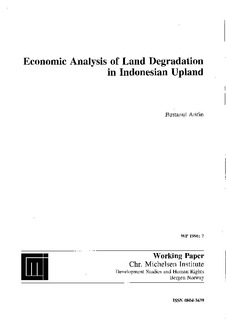| dc.description.abstract | The objective of this research is to determine factors affecting land degradation in the upland in Indonesia, and to suggest appropriate policies regarding land-use. The regression results indicate that about half of the variance in land degradation in the regional data set is explained by the variation in cropping intensity, population pressure, income per capita, transmigration, and conditioning variables. Sensitivity analysis shows that the variables for population pressure and income per capita in both data sets, and transmigration in the provincial data set are robust in explaining variation in land degradation. The results of this study could be taken as a signal to reevaluate the rice self-sufficiency policy. Efforts to increase the productivity of rice should not always be interpreted as an expansion of rice area, especially for some marginal land outside Java. Several policy recommendations are suggested by the analysis: (a) reduce intensive land-use practices, (b) reduce population pressure, and (c) promote a strategy to raise income. | |
